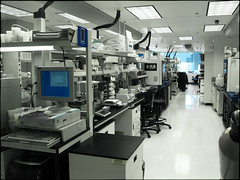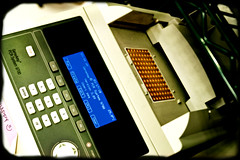Honestly, I know what it all does, really.
Anyway, in lieu of a "real" blog post full of pithy and insightful commentary (yes, yes, I know, that's definitely not what you've come to expect here, is it?), I give you: a quick guide to some of the lab widgets. In one part. With captions. Do feel free to clickety-click on the photos, if you'd like to see them a little bit larger.
Here's part of the lab - for reference, the whole operation is about 15 times the size of this aisle:

Right. First, we have an Applied Biosystems 9700 thermocycler, essentially a programmable machine that changes the temperature of teeny, tiny test tubes in a predictable way. Its primary use is for taking vanishingly small amounts of DNA, and making "carbon copies" of them via the famous, Nobel-Prize-Winning technique known as the Polymerase Chain Reaction. One application is "cycle sequencing", by which we take a piece of DNA and make copies of it in such a way that we can figure out its "genetic code" of those (warning - hackneyed description alert!) "building blocks of life", the nucleotide bases A, C, G and T.

Now, a pair of mighty Beckman Coulter BioMek NXP robots, used for pipetting 96 tiny volumes of liquid at a time:

One thing we use those for is to "clean up" DNA sequencing reactions that come out of the aforementioned thermocyclers. These buffed, polished and waxed reactions then get loaded into an instrument that separates each reaction down a teeny, tiny, skinny little capillary filled with a gel substance. Count carefully, there really are 96 of them:

This is fabulous technology, and similar in many respects to the methods used to complete the Human Genome Project. Nowadays, we have higher-throughput instruments, that generate DNA sequence at rates approaching a million times faster, such as this rather unprepossessing looking Applied Biosystems SOLiD (version "3 plus", in case you were wondering):

Yes, it really is big, and yes, it really does have its own computer nodes underneath it - the panels are off to allow some of the heat to escape.
So there you go, the cook's tour around a part of the lab, conveniently located across the hall from my office, just far enough away that the people who work in it don't have to worry about me actually pressing any buttons or tripping over anything. The sharp-eyed among you will also notice that in the first photo, everybody was clearly hiding from me. I like to believe it was because I was holding a camera, but you never know.
5 comments:
Excellent Ricardipus. Now I understand it all.... My wife says I lie a lot.. But the pics are good!
Thank you sir. Remember, I've met your wife (twice!), and I feel it would be impolite of me to disbelieve her. :)
The lab is 15 times the size of that corridor. Cor! Some size, wuh?
Yup, it's big. About two thirds of a 24,000 square foot floor (so, um... that would be 16,000 square feet I guess?).
Sequencers are sexy. There, I've said it now, and it feels good... :P
Post a Comment